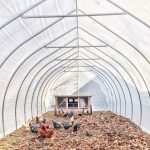Chickens possess varying degrees of cold tolerance, which is influenced by several factors. Breed plays a significant role, with some varieties like Plymouth Rock, Orpington, and Wyandotte demonstrating superior cold hardiness compared to Mediterranean breeds such as Leghorns and Minorcas. Understanding the specific cold tolerance of different chicken breeds is essential for providing appropriate care and shelter during winter months.
Age, health status, and acclimatization also affect a chicken’s ability to withstand cold temperatures. Young chicks and elderly birds are typically more vulnerable to cold stress due to less efficient body temperature regulation. Similarly, chickens that are ill or underweight struggle more in cold conditions.
Careful monitoring of the flock during winter is crucial, and adjustments to care practices may be necessary to maintain the birds’ health and well-being.
Table of Contents
- 1 Providing Proper Shelter and Bedding
- 2 Ensuring Access to Fresh Water
- 3 Adjusting Feed and Nutrition
- 4 Protecting Combs and Wattles from Frostbite
- 5 Monitoring Health and Behavior
- 6 Implementing Additional Heat Sources
- 7 FAQs
- 7.1 What are some tips for keeping chickens warm in freezing temperatures?
- 7.2 What should I feed my chickens in cold weather?
- 7.3 How can I prevent my chickens’ water from freezing in cold temperatures?
- 7.4 What are some signs that my chickens are too cold?
- 7.5 How can I protect my chickens from frostbite in freezing temperatures?
Key Takeaways
- Chickens can tolerate cold temperatures, but it’s important to understand their limits and how to keep them safe in cold weather.
- Providing proper shelter and bedding, such as straw or wood shavings, can help chickens stay warm and dry during cold weather.
- Ensuring access to fresh water is crucial, as chickens can easily become dehydrated in cold temperatures.
- Adjusting feed and nutrition to include more calories and protein can help chickens maintain their body temperature in cold weather.
- Protecting combs and wattles from frostbite by applying petroleum jelly or using chicken saddles can prevent injury and discomfort for chickens in cold weather.
- Monitoring the health and behavior of chickens, such as signs of lethargy or decreased egg production, can help identify any issues related to cold weather stress.
- Implementing additional heat sources, such as heat lamps or heated perches, can provide extra warmth for chickens during extreme cold temperatures.
Providing Proper Shelter and Bedding
Proper Shelter and Ventilation
A well-ventilated but draft-free coop is essential for keeping chickens warm and healthy during the winter months. The coop should be insulated to some extent, but it’s important to strike a balance between insulation and ventilation to prevent moisture buildup, which can lead to respiratory issues in chickens.
Adequate Bedding and Insulation
Providing adequate bedding such as straw or wood shavings will help insulate the coop and keep the chickens warm. It’s also important to ensure that the coop is free from drafts and leaks, as these can significantly lower the temperature inside the coop and make it harder for chickens to stay warm. Insulating the walls and windows of the coop, as well as sealing any gaps or cracks, can help maintain a comfortable temperature for the chickens.
Roosts for Comfort and Safety
Providing roosts for the chickens to perch on will also help keep them off the cold ground and prevent frostbite on their feet.
Ensuring Access to Fresh Water

Access to fresh water is crucial for chickens year-round, but it becomes even more important during the winter months. Chickens need water to stay hydrated and regulate their body temperature, so it’s essential to ensure that their water supply doesn’t freeze. There are several ways to prevent water from freezing, such as using heated waterers, insulating water containers, or using heated bases to keep the water from freezing.
In addition to preventing freezing, it’s important to regularly check the water supply to ensure that it’s clean and free from contaminants. Chickens are more susceptible to illness in cold weather, so providing them with clean water is essential for maintaining their health. It’s also a good idea to provide multiple water sources in case one freezes or becomes contaminated, ensuring that the chickens always have access to fresh water.
Adjusting Feed and Nutrition
During the winter months, chickens require additional energy to stay warm and maintain their body temperature. Adjusting their feed and nutrition accordingly is crucial for keeping them healthy and comfortable in cold weather. Providing a high-quality layer feed with increased protein content can help chickens maintain their body condition and produce eggs during the winter months.
Additionally, offering supplemental treats such as scratch grains or mealworms can provide extra energy for the chickens. It’s also important to monitor the chickens’ feed consumption and adjust their rations as needed. Chickens may eat more during the winter to compensate for the energy they expend staying warm, so it’s important to ensure that they have access to an adequate amount of feed.
Additionally, providing access to grit and oyster shell will help chickens digest their food properly and maintain good eggshell quality during the winter months.
Protecting Combs and Wattles from Frostbite
Chickens’ combs and wattles are particularly susceptible to frostbite in cold weather, as they have a high blood supply and are not covered by feathers. Protecting these vulnerable areas is crucial for preventing frostbite and maintaining the chickens’ health. Applying a thin layer of petroleum jelly or a similar protective balm to the combs and wattles can help insulate them from the cold and prevent frostbite.
Additionally, providing adequate ventilation in the coop will help prevent moisture buildup, which can exacerbate the risk of frostbite. In extreme cold temperatures, it may be necessary to provide additional protection for the combs and wattles. Using chicken saddles or aprons can help cover these areas and provide an extra layer of insulation.
It’s also important to monitor the chickens closely for signs of frostbite, such as discoloration or swelling of the combs and wattles. If frostbite occurs, it’s important to provide immediate care and take steps to prevent further damage.
Monitoring Health and Behavior

Recognizing Signs of Illness
Keeping a close eye on your flock for signs of illness or distress will allow you to address any issues promptly and prevent them from escalating. Some common signs of illness in chickens include lethargy, decreased appetite, respiratory issues, or changes in behavior.
Observing and Adjusting Care
In addition to monitoring for signs of illness, it’s essential to observe your chickens’ behavior and make adjustments to their care as needed. For instance, if you notice that your chickens are huddling together or fluffing up their feathers excessively, it may be a sign that they are cold and need additional warmth.
Providing Comfort and Care
Providing supplemental heat sources or adjusting their bedding can help keep them comfortable and healthy during the winter months. By being attentive to your chickens’ needs, you can ensure they stay happy and healthy throughout the cold winter season.
Implementing Additional Heat Sources
In some cases, providing additional heat sources may be necessary to keep chickens warm in extreme cold temperatures. There are several options for supplemental heat sources, such as heat lamps, radiant heaters, or heated pads. It’s important to use caution when implementing these heat sources, as they can pose a fire hazard if not used properly.
Additionally, it’s important to ensure that the heat source is positioned safely in the coop and doesn’t pose a risk of burns or overheating for the chickens. When using heat sources in the coop, it’s important to monitor the temperature closely and make adjustments as needed. Chickens are sensitive to sudden changes in temperature, so it’s important to provide gradual and consistent warmth to prevent stress or shock.
Additionally, it’s important to provide adequate ventilation in the coop when using heat sources to prevent moisture buildup and maintain good air quality for the chickens. In conclusion, caring for chickens in cold weather requires careful attention to their specific needs and behaviors. By understanding their cold tolerance, providing proper shelter and bedding, ensuring access to fresh water, adjusting feed and nutrition, protecting combs and wattles from frostbite, monitoring health and behavior, and implementing additional heat sources when necessary, you can ensure that your flock stays healthy and comfortable during the winter months.
With proper care and attention, your chickens can thrive even in the coldest of temperatures.
If you’re interested in learning more about the breeding habits of poultry, you might want to check out this article on what is the incubation period for goose eggs. Understanding the incubation period for goose eggs can be crucial for successful breeding and hatching.
FAQs
What are some tips for keeping chickens warm in freezing temperatures?
Some tips for keeping chickens warm in freezing temperatures include providing a well-insulated coop, using heat lamps or heated waterers, and ensuring adequate ventilation while avoiding drafts.
What should I feed my chickens in cold weather?
In cold weather, it’s important to provide your chickens with a balanced diet that includes plenty of protein and energy to help them stay warm. This can include high-quality poultry feed, as well as supplemental treats like cracked corn or mealworms.
How can I prevent my chickens’ water from freezing in cold temperatures?
To prevent your chickens’ water from freezing in cold temperatures, you can use heated waterers, add a small amount of apple cider vinegar to the water to lower its freezing point, or simply check and replace the water frequently throughout the day.
What are some signs that my chickens are too cold?
Signs that your chickens may be too cold include huddling together for warmth, decreased egg production, lethargy, and frostbite on their combs or wattles. It’s important to monitor your chickens closely in cold weather and make adjustments to their environment as needed.
How can I protect my chickens from frostbite in freezing temperatures?
To protect your chickens from frostbite in freezing temperatures, you can apply petroleum jelly to their combs and wattles to help insulate and protect them from the cold. Additionally, ensuring that their coop is well-insulated and free from drafts can help prevent frostbite.
Meet Walter, the feathered-friend fanatic of Florida! Nestled in the sunshine state, Walter struts through life with his feathered companions, clucking his way to happiness. With a coop that’s fancier than a five-star hotel, he’s the Don Juan of the chicken world. When he’s not teaching his hens to do the cha-cha, you’ll find him in a heated debate with his prized rooster, Sir Clucks-a-Lot. Walter’s poultry passion is no yolk; he’s the sunny-side-up guy you never knew you needed in your flock of friends!







